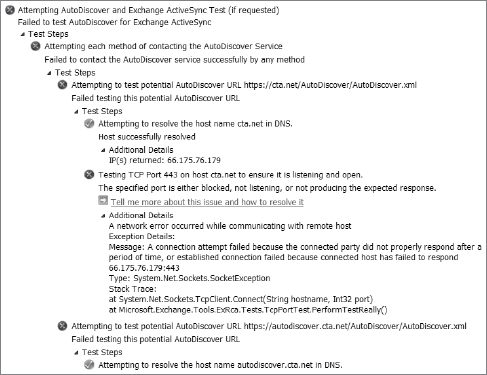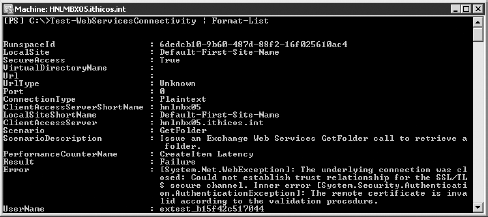2. Test-*Connectivity Cmdlets
One of the most fundamental changes in Exchange
Server 2010 sees the final shift of mailbox access away from the
Mailbox server role over to the Client Access server role. Of course,
Exchange ActiveSync and Outlook Web App clients also access the Client
Access server, which means that your Client Access servers are even
more critical to an Exchange environment than in the past. In other
words, you need to make sure your clients can access the Client Access
servers in all situations. Microsoft has long recommended that you
deploy at least two Client Access servers in every site that houses a
Mailbox server to ensure full redundancy. This recommendation assumes
that your site definitions correctly include all appropriate subnets,
that your servers' IP addresses are correctly configured, and that all
DNS records are properly registered in the appropriate zones.
If your client can access Autodiscover, you know
that you can connect to at least one Client Access server, but it's
possible to access one service on a Client Access system but not
others. How can you tell if other necessary components on the Client
Access server are functioning properly? Earlier we talked about two
very useful cmdlets—Test-SystemHealth and Test-ServiceHealth—that
can help diagnose general issues on a server. However, sometimes you
can take a more surgical approach and focus on one protocol. For this,
we'll use a series of cmdlets called Test-*Connectivity (where * is the protocol or client you're testing).

|
You've probably noticed that troubleshooting
Exchange Server 2010 involves a lot of cmdlets, and you're right: there
are a lot of troubleshooting cmdlets! The Exchange product group worked
hard to ensure that administrators had easy-to-use, robust, focused
troubleshooting tools right at their fingertips, and the resulting
family of cmdlets serves as a testament to those efforts.
|
Depending on the client you're testing, you'll want to use one of the following cmdlets:
Most of the cmdlets above are all pretty
self-explanatory; they correspond to the most popular connectivity
models (although it's important to note that the cmdlets to test POP3
and IMAP4 connectivity don't include the version numbers for the
protocols—it's just POP and IMAP). The Test-OutlookConnectivity cmdlet (shown in Figure 4)
covers both MAPI and Outlook Anywhere connectivity, so you don't need
separate ones (although as you've seen, there is also a separate Test-MapiConnectivity cmdlet).

The cmdlets Test-WebServicesConnectivity (shown in Figure 5) and Test-OutlookWebServices have a lot of overlap, and the essential difference is that the former checks only the web services.

The Test-OutlookWebServices cmdlet tests
all the web services that the clients might use during normal client
activity such as Autodiscover, Availability Service, and Offline
Address Book. It's primarily used to troubleshoot Outlook Anywhere
clients (for obvious reasons), but is still useful in other
environments. Prior to running the cmdlet, though, you should run the New-TestCasConnectivityUser.ps1 script to create test users for your CAS server or servers.
The suite of cmdlets listed here provides
comprehensive coverage for connectivity issues. If you can run these
successfully but still can't connect your client, there's a good chance
that the problem isn't with Exchange at all.
Client connectivity is a complex and
involved process, and the number of troubleshooting tools reflects
this. Outlook includes some basic tools, including the Test E-mail
AutoConfiguration option, but for more detailed troubleshooting you'll
probably need to use one of the incredibly useful Test-*Connectivity cmdlets. For external connections, you have the added luxury of the Exchange Remote Connectivity Analyzer (www.testexchangeconnectivity.com). You can also test the other services provided by Client Access servers with the Test-OutlookWebServices
cmdlet. Taken as a group, these tools should allow you to quickly
determine whether client connectivity problems are caused by the
Exchange infrastructure.